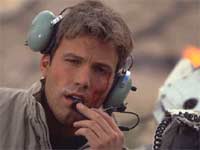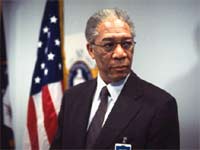Sum Of All Fears - Production Notes
| Sum Of All Fears | ||
| Production Notes | ||
| Because accuracy and realism were vital to the telling of “The Sum of All Fears,” the producers sought out military and government officials to advise them on the film. Among those most helpful to the production was Air Force Entertainment Liaison Chief Charles E. Davis, the Department of Defense project officer assigned to the film. “We were delighted when asked by the production company to provide assistance,” says Davis. “We worked closely with the producers and director to identify their needs and then offer our recommendations on how those needs could best be met. I can tell you this: “The Sum of All Fears” is probably one of the most technically correct movies released in a long time.” In addition to providing the production with a host of technical advisors, the Department of Defense also made it possible to film numerous aircraft including a wing of F-16 and B-2 aircraft, as well as U.S. Army Blackhawk helicopters. For the scene in which the U.S. President is rescued by the Marines, the Department of Defense arranged for the production to film with three CH- 53 helicopters manned by a team of Marines from the reserve unit in Willowgrove, Pennsylvania. |  |
 |
| The look of the film also benefited from the art department’s extensive access to the Pentagon, the White House and the National Airborne Command Center. To that end, the White House Situation Room, the White House Mess, the Pentagon Control Center and the Hotline room are all based very closely on the actual places of operation. In fact, the art crew, under supervision, was permitted to take photographs, make sketches and take notes that proved invaluable in recreating the physical details of the sets built and dressed on stage. In addition, the Department of Defense allowed the production to film the actual National Airborne Command Center plane taking off, flying and refueling. To prepare for his role as a CIA analyst, Affleck spent time at CIA headquarters in Langley, Virginia. There, under the tutelage of Chase Brandon, a 25-year veteran of CIA field operations (who now serves as film liaison to the agency’s Office of Public Affairs), Affleck was given a tour of the facility and the opportunity to spend time interviewing real Russian analysts. “The initial request for assistance came from the senior production team,” explains Brandon. “They wanted the director, the producers, some of the set decorators and costuming people to come and see CIA headquarters, to basically have a chance to see the terrain and what we look like, in order to make a realistic movie. We extended the offer to have some of the talent come because, having worked with moviemakers in the past, we know that the people who are portraying CIA officers invariably learn more about the role when they get to see, talk to and be around actual agency officers. “One of the things, I think, that benefited Ben as he walked around the agency was to simply feel the atmosphere of the place,” adds Brandon. “There’s a very palpable sense of mission and importance to what goes on there, and I think Ben picked up on that simply by being in the building. But what, undoubtedly, helped him more than anything was to spend several hours with actual Russian analysts talking about the issues they deal with every day. He was able to engage in some analytical exercises, and I think that clearly enhanced his role as Jack Ryan.” Affleck says that he found his time at the CIA invaluable in preparing for his role, but was surprised at the normalcy of everything. “It was very interesting,” recalls the actor. “It wasn’t some kind of cloak-and-dagger operation, but more like an office with a very diverse group of people -- highly competent and very smart people -- who are dedicated, patriotic Americans. “Most people at the CIA aren’t spies,” asserts Affleck. “They’re individuals writing documents and postulating ideas. In some ways, the analysts at the CIA are very much like graduate students. What they do is collect intelligence and become experts on various people, countries and situations, and then they synthesize their information.” The filmmakers’ penchant for realism is perhaps seen nowhere more clearly than in the Kremlin sequences, where the decision was made to have the actors play out their scenes in Russian. For the actors, this presented an interesting challenge, but with the help of Russian dialect coach Natasha Rybina, that challenge was met. “Speaking even a little bit of Russian seems like an ocean of Russian when you don’t speak the language,” says Ciarán Hinds (President Nemerov). “The Russians use the Cyrillic alphabet, which is completely different from the English alphabet. Thankfully, we had Natasha to whip us into shape.” For Michael Byrne (Grushkov), the process of learning to speak his lines in Russian was a formidable task, to say the least, or as he puts it, “a genuine nightmare.” Says Liev Schreiber (CIA Operative John Clark): “It was difficult, but really fun to play a scene in another language, and learn how people express themselves through a language that’s very different from our own.” To help the actors with their portrayals and add further authenticity to the Kremlin scenes, the filmmakers peppered the cast with real Russian actors. “There’s a certain kind of verisimilitude you get from using people who actually speak the language and know the culture,” says Robinson. “There’s just a way that they stand, a way that they speak, a way that they look at you, that really allows us to create a greater semblance of reality. We were very lucky to get Lev Prygounov (General Saratkin) and Alexander Belyavsky (Admiral Ivanov), both very well-known actors in Russia, as well as quite a few native-born Russians who now live on this side of the ocean. Ciarán Hinds spent a lot of time with these actors. They helped coach him, giving him ways of standing, looking and talking that really helped him flesh out what was already a pretty spectacular performance.” Although “The Sum of All Fears” is certainly about fine acting, it is also about amazing action sequences. To achieve the level of realism and excitement the filmmakers were looking for, the expertise of special effects coordinator Al Di Sarro and visual effects supervisor Glenn Neufeld were called into play. Di Sarro and his special effects crew created explosive pyrotechnics, rain, snow, flames, wind, smoke and ash. They were also responsible for the mechanics in the film, including the “controlled” crash of a Huey helicopter, and the design and construction of a 120-foot gimbaled platform, which rocked and tipped the National Airborne Command Center set in order to simulate aircraft turbulence. As for the massive bomb at the football game, which is one of the most important sequences in the film, Neufeld and his visual effects team used everything from sophisticated computer-generated animation to the more traditional method of green-screen compositing. All of these high-tech effects, coupled with hair-raising feats overseen by stunt coordinator Terry J. Leonard, created unforgettable, action-packed sequences sure to stay with audiences long after they leave the theatre. Principal photography for “The Sum of All Fears” began in Montreal, Canada, on February 12, 2001. While the film’s main locations were in Montreal and surrounding areas, second-unit filming also took place in Washington, D.C., Baltimore, Russia and the California desert. Over the course of the 4½-month shoot, production designer Jeannine C. Oppewall and her team designed, constructed and dressed over 100 different sets and locations to transform Montreal and its environs into, at varying times, Washington, D.C., Baltimore, Russia, Vienna, the Ukraine, the Golan Heights and Damascus. The film’s largest and most complex sets, such as CIA headquarters, the Pentagon, Dressler’s apartment, the White House situation room, Baltimore General Hospital and the interior of the National Airborne Command Center -- which is actually a 747 used in national emergencies -- were constructed on soundstages in two Montreal studios. To create the sets for the Kremlin, Oppewall utilized a number of different buildings in Montreal. For example, the Kremlin command bunker, as well as the Arzamaz Nuclear Facility and Decommissioning Area, were located in the Atwater Filtration Plant. The reception room, where Ryan and Cabot meet Nemerov for the first time, was in the Windsor Hotel. The ballroom of that same hotel served as the site of the Washington Correspondents’ dinner. Nemerov’s and Zorkin’s offices, as well as Nemerov’s bedroom, were created in an old mansion known as the Unitas House, while Montreal’s City Hall doubled for the Kremlin’s ceremonial hall. President and his senior staff convene to deal with the impending crisis at the start of the film. As for the tunnels and stairways surrounding and leading to the interior sanctum of the situation room, the production used the historic Diefenbunker, a structure built by the Canadian government in the late ’50s in response to the Cold War. Located on the outskirts of Ottawa, Ontario, the Diefenbunker was intended to shelter key political and military personnel during a massive attack. A huge four-story bunker buried deep under a hillside, the Diefenbunker was designed to withstand all but a direct hit by a weapon of mass destruction. Montreal was the location site for numerous sets, and some sites served dual purposes. For example, the old Redpath Sugar Refinery doubled as an abandoned army base in the Ukraine and an industrial Baltimore neighborhood, which was reduced to flames and rubble in the aftermath of the massive explosion at the football stadium. The Montreal Harbor stood in for the Baltimore docks, and Montreal’s Masonic Temple provided the backdrop for the Sensitive Compartmentalized Information Facility (SCIF), a high-tech glass and metal soundproof room within a room where Cabot briefs the Intelligence Committee on the Russian situation. As for Jack Ryan’s apartment, Montreal’s historic Notman House was chosen, and Mount Royal Park, thanks to the city’s record snowfalls last year, provided the filmmakers with an ideal location to shoot the Russian forest sequences. One of the film’s most multifaceted sequences, the all-important football game, was shot in Montreal’s Olympic Stadium, which for three days was transformed into the Baltimore Forum. To ensure that the sequence appears authentic, the filmmakers secured the services of veteran NFL referee Jerry Markbreit as a technical advisor. In addition, stunt coordinator Terry J. Leonard, a former pro football player for the British Columbia Lions, put the real-life Montreal Alouettes and the Toronto Argonauts through their paces as they portrayed the fictional Chicago Rockets and Alabama Gators to thousands of enthusiastic Montrealers enlisted to play their fans. To guarantee authenticity with regard to political matters, the filmmakers consulted extensively with advisors from the CIA and the Department of Defense, including the Air Force, the Marines, the Army and the Navy. In fact, a myriad of topnotch experts provided technical advice on everything from what would occur during and after a massive explosion, to the procedures involved in the building and handling of weapons of mass destruction. Indeed, authenticity and realism -- right down to how to dress the extras with the proper military detail – pretty much sums up “The Sum of All Fears.” |
|
|
